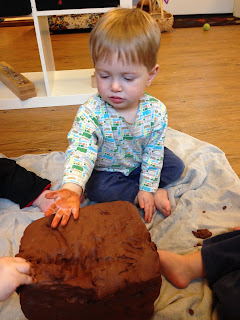"Oh! Yes, my eye. Please give it space. You can touch your own eye as much as you'd like," I say blocking the hand. We spend a moment looking at each other's eyes as we point to them.
Later someone gets very close to a friend and wraps his arm around them. They are smiling as they go in for a hug, but then the other child begins to squeal and pull away.
"I wonder if they would like a hug? I hear and see them pulling away. Lets try again and ask, 'Would you like a hug?'" I turn to the other child as ask the question and open my arms in invitation. They shake their head no and walk away.
"They don't want a hug right now. I'm available for a hug, if you'd like!" This produces a smile and we hug, before returning to play.
We are all squished together on the cozy chair. Some are half sitting on the arm with my arm around their back for safety. Everyone is touching, arms and legs tucked over and under each other. Someone begins to squirm and I say calmly, "Are you ready to get down? I know everyone's very close. If we can be careful it just might work." They too calm down and we sing a song together.
All of these moments are building on our emerging sense of self and growing awareness of others, both peers and how we fit within our cohort community. When I give language to body parts, we can then use them in conversations around emotional awareness. We are at the age where the children in cohort 6 are beginning to feel some strong emotions. They experience big feelings mixed with trying to work out how to react. Often there is yelling, hitting, throwing toys, crying or other big movements. There are times when these things work and times when it does not.
When they not only understand words for labeling their body, but understand the commonality between others ( We both have eyes! We both have hair! We both have..... ) then these interactions carry more meaning. It is a natural progression that toddlers are especially working on: categorizing, applying, expanding. Seeing both similarities and differences are the very first steps for emotional awareness and empathy.




































